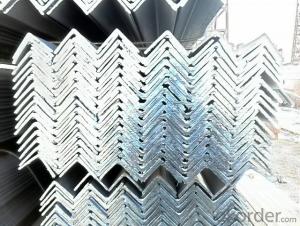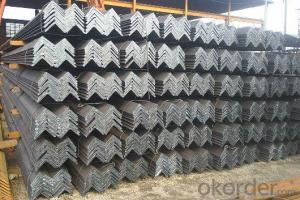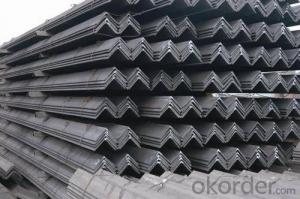Hot Rolled Equal Angles with High Quality
- Loading Port:
- Tianjin
- Payment Terms:
- TT OR LC
- Min Order Qty:
- 25 m.t.
- Supply Capability:
- 20000 m.t./month
OKorder Service Pledge
OKorder Financial Service
You Might Also Like
Product Description:
OKorder is offering Hot Rolled Equal Angles at great prices with worldwide shipping. Our supplier is a world-class manufacturer of steel, with our products utilized the world over. OKorder annually supplies products to European, North American and Asian markets. We provide quotations within 24 hours of receiving an inquiry and guarantee competitive prices.
Product Applications:
Hot Rolled Equal Angles are ideal for structural applications and are widely used in the construction of buildings and bridges, and the manufacturing, petrochemical, and transportation industries.
Product Advantages:
OKorder's Hot Rolled Equal Angles are durable, strong, and resist corrosion.
Main Product Features:
· Premium quality
· Prompt delivery & seaworthy packing (30 days after receiving deposit)
· Corrosion resistance
· Can be recycled and reused
· Mill test certification
· Professional Service
· Competitive pricing
Product Specifications:
Manufacture: Hot rolled
Grade: Q195 – 235
Certificates: ISO, SGS, BV, CIQ
Length: 6m – 12m, as per customer request
Packaging: Export packing, nude packing, bundled
Sizes: 25mm-250mm | ||
a*t | ||
25*2.5-4.0 | 70*6.0-9.0 | 130*9.0-15 |
30*2.5-6.6 | 75*6.0-9.0 | 140*10-14 |
36*3.0-5.0 | 80*5.0-10 | 150*10-20 |
38*2.3-6.0 | 90*7.0-10 | 160*10-16 |
40*3.0-5.0 | 100*6.0-12 | 175*12-15 |
45*4.0-6.0 | 110*8.0-10 | 180*12-18 |
50*4.0-6.0 | 120*6.0-15 | 200*14-25 |
60*4.0-8.0 | 125*8.0-14 | 250*25 |
FAQ:
Q1: Why buy Materials & Equipment from OKorder.com?
A1: All products offered byOKorder.com are carefully selected from China's most reliable manufacturing enterprises. Through its ISO certifications, OKorder.com adheres to the highest standards and a commitment to supply chain safety and customer satisfaction.
Q2: What makes stainless steel stainless?
A2: Stainless steel must contain at least 10.5 % chromium. It is this element that reacts with the oxygen in the air to form a complex chrome-oxide surface layer that is invisible but strong enough to prevent further oxygen from "staining" (rusting) the surface. Higher levels of chromium and the addition of other alloying elements such as nickel and molybdenum enhance this surface layer and improve the corrosion resistance of the stainless material.
Q3: Can stainless steel rust?
A3: Stainless does not "rust" as you think of regular steel rusting with a red oxide on the surface that flakes off. If you see red rust it is probably due to some iron particles that have contaminated the surface of the stainless steel and it is these iron particles that are rusting. Look at the source of the rusting and see if you can remove it from the surface.
Images:
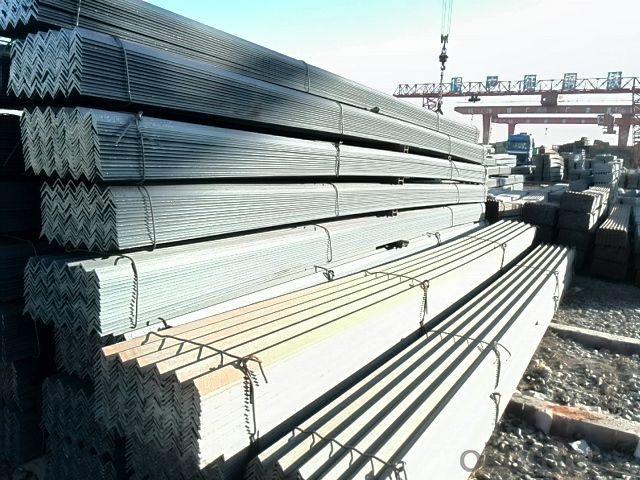
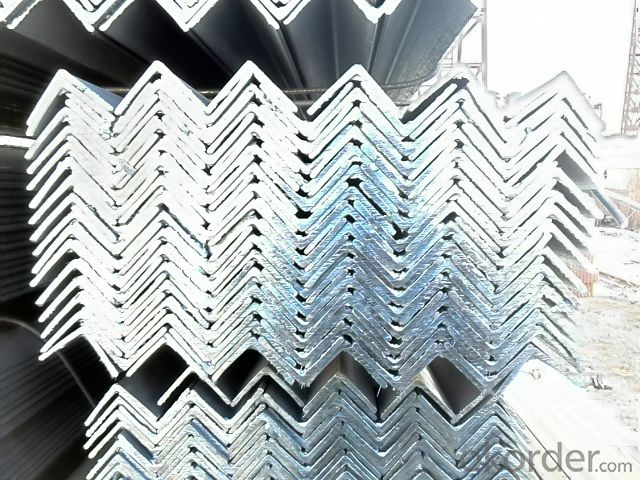

- Q:What are the different methods for reinforcing steel angles?
- Depending on the specific structural needs and design requirements, there are various methods available for reinforcing steel angles. Some commonly used methods are as follows: 1. Welding is the most frequently employed technique for reinforcing steel angles. By using heat and pressure, two or more steel angles can be joined together to create a strong and durable connection. To maintain the integrity of the reinforcement, it is crucial to follow proper welding techniques and procedures. 2. Bolting is another method that can be utilized to reinforce steel angles. This involves inserting bolts through holes in the angles and tightening them to establish a secure connection. This method is often preferred when adjustability or removability of the reinforcement is necessary. 3. Riveting, a traditional technique, can also be employed to reinforce steel angles. It entails inserting a pin or rivet through holes in the angles and securing it by deforming the pin's end. This creates a robust and permanent connection between the angles. 4. Adhesive bonding can be used in certain cases to reinforce steel angles. This method involves applying a specialized adhesive to the surfaces of the angles and pressing them together. As the adhesive hardens, it forms a strong bond between the angles. 5. Plate strengthening is an option for additional reinforcement. Steel plates can be attached to the angles, typically through welding or bolting, to enhance their strength and load-bearing capacity. 6. Reinforcing bars, commonly referred to as rebar, can also be employed to reinforce steel angles. These bars are typically embedded into the concrete or masonry structure and extend into the angles to provide additional strength and support. To determine the most suitable method for reinforcing steel angles based on specific project requirements and structural considerations, it is essential to consult with a structural engineer or design professional.
- Q:Can steel angles be used in oil and gas pipeline installations?
- Yes, steel angles can be used in oil and gas pipeline installations. Steel angles are commonly used in the construction of pipelines as they provide structural support and reinforcement. They are typically used for connecting and securing various components of the pipeline system, such as pipe joints, flanges, and supports. The strong and durable nature of steel angles makes them suitable for withstanding the harsh conditions and high-pressure environments often encountered in oil and gas pipeline installations.
- Q:What is the maximum load capacity for a steel angle bracket?
- The maximum load capacity for a steel angle bracket can vary depending on factors such as the size, thickness, and quality of the bracket. It is best to consult the manufacturer's specifications or engineering guidelines to determine the specific maximum load capacity for a particular steel angle bracket.
- Q:What are the different welding methods used for steel angles?
- There are several different welding methods commonly used for steel angles, including Shielded Metal Arc Welding (SMAW), Gas Metal Arc Welding (GMAW), Flux-Cored Arc Welding (FCAW), and Gas Tungsten Arc Welding (GTAW). Each method has its own advantages and suitability for specific applications, but all are capable of effectively joining steel angles and providing strong, durable welds.
- Q:What is the bending capacity of a steel angle?
- The bending capacity of a steel angle refers to its ability to withstand and resist bending forces without experiencing permanent deformation or failure. This capacity is influenced by various factors such as the angle's dimensions, material properties, and the specific loading conditions applied. It is typically determined through rigorous engineering calculations and testing to ensure structural integrity and safety.
- Q:How do you determine the resistance to lateral-torsional buckling of a steel angle?
- There are several factors that need to be taken into account when determining the resistance to lateral-torsional buckling of a steel angle. The primary factors that influence this resistance are the geometric properties of the angle section, the material properties of the steel, and the boundary conditions of the member. 1. Geometric properties: The resistance to lateral-torsional buckling is affected by critical geometric properties such as the length, width, thickness, and slenderness ratio of the angle section. The slenderness ratio, which is the ratio of the length to the radius of gyration of the section, is particularly important as it indicates the stability of the member. A higher slenderness ratio implies a greater susceptibility to lateral-torsional buckling. 2. Material properties: The resistance to lateral-torsional buckling also depends on the material properties of the steel angle. Factors such as the yield strength, modulus of elasticity, and the shape of the stress-strain curve play a significant role in determining the capacity of the steel angle to withstand bending and twisting moments without buckling. 3. Boundary conditions: The resistance to lateral-torsional buckling is significantly influenced by the boundary conditions of the steel angle. The type of support and the loading conditions both play a crucial role. The type of support, whether it is simply supported or fixed, determines the level of rotational and translational constraints on the member. Similarly, the applied loads, such as point loads, distributed loads, or moments, determine the bending and twisting moments that act on the angle section. To determine the resistance to lateral-torsional buckling, engineers typically refer to relevant design codes and standards, such as the AISC Manual or Eurocode. These codes provide design formulas and tables that take into consideration the geometric properties, material properties, and boundary conditions. They allow engineers to calculate the critical moment and corresponding resistance to lateral-torsional buckling for the steel angle. Additionally, advanced computer simulations, such as FEA software, can be used to obtain more accurate results by considering complex loadings and boundary conditions.
- Q:How do steel angles perform under impact or dynamic loading conditions?
- Steel angles are known for their excellent performance under impact or dynamic loading conditions. Their shape provides structural stability and resistance to bending, making them highly effective in withstanding sudden forces and vibrations. The high strength of steel angles allows them to absorb energy and distribute it evenly, reducing the risk of deformation or failure. Overall, steel angles are reliable and dependable in demanding situations with impact or dynamic loading.
- Q:Can steel angles be used in marine applications?
- Indeed, one can utilize steel angles for marine purposes. Given their exceptional strength and durability, steel angles are frequently employed in shipbuilding, offshore platforms, and various marine structures. They serve to offer structural reinforcement and assist in the dispersion of weight and stress within the marine setting. When coated with protective substances or galvanized, steel angles exhibit resistance to corrosion. Nevertheless, it remains crucial to carefully select the appropriate grade of steel angle that is explicitly designed for marine use, guaranteeing optimal performance and longevity in the demanding and corrosive saltwater environments.
- Q:What are the different types of steel angles used in automotive applications?
- There are several types of steel angles used in automotive applications, including equal angles, unequal angles, and L-shaped angles. These angles are used to provide structural support, reinforcement, and stability to various components of vehicles such as chassis frames, body panels, and suspension systems.
- Q:Can steel angles be used in agricultural or farm applications?
- Yes, steel angles can be used in agricultural or farm applications. Steel angles are versatile and durable structural components that are commonly used in various industries, including agriculture. They can be utilized in farm equipment, such as machinery frames, trailers, and fences. Steel angles are ideal for these applications due to their strength and stability, which can withstand heavy loads and harsh weather conditions. Additionally, they can be easily welded, bolted, or fastened together, allowing for easy customization and construction of various agricultural structures. Overall, steel angles are a reliable and practical choice for agricultural and farm applications.
1. Manufacturer Overview |
|
|---|---|
| Location | |
| Year Established | |
| Annual Output Value | |
| Main Markets | |
| Company Certifications | |
2. Manufacturer Certificates |
|
|---|---|
| a) Certification Name | |
| Range | |
| Reference | |
| Validity Period | |
3. Manufacturer Capability |
|
|---|---|
| a)Trade Capacity | |
| Nearest Port | |
| Export Percentage | |
| No.of Employees in Trade Department | |
| Language Spoken: | |
| b)Factory Information | |
| Factory Size: | |
| No. of Production Lines | |
| Contract Manufacturing | |
| Product Price Range | |
Send your message to us
Hot Rolled Equal Angles with High Quality
- Loading Port:
- Tianjin
- Payment Terms:
- TT OR LC
- Min Order Qty:
- 25 m.t.
- Supply Capability:
- 20000 m.t./month
OKorder Service Pledge
OKorder Financial Service
Similar products
New products
Hot products
Related keywords
